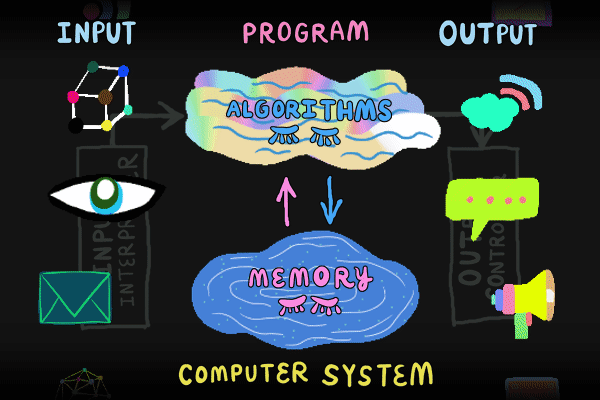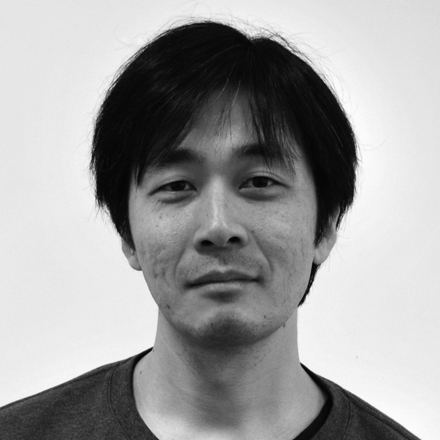インタラクティビティを再定義する - Redefining Interactivity
 Based on Formula for Computer Art by Jim Campbell
Based on Formula for Computer Art by Jim Campbell
約70年前、数学者のNorbert Wienerらが提唱したサイバネティクスは、通信、制御、統計力学の観点から、動物と機械の機能を統一的に理論化する大胆な問いかけでした。同時に、既存の諸分野を越境して空白地帯を探求する学問の在り方を提案するものでした。当時、大きな衝撃を持って受け止められた考え方は、科学、技術、産業、文化に大きな影響を与え、人と機械が共生する世界を予見させる作品が次々と生まれました。中でも顕著なのが、メディアアート、ゲーム、広告などにおけるインタラクティブな作品です。インタラクティブな作品は、鑑賞者の行動や環境などの情報を入力として、これを解釈するアルゴリズムを作者が記述し、映像、音声、環境の変化などの出力にマッピングすることにより、鑑賞者が作品を体験し、作者と対話します。一見、これは自明なことのように思えます。しかしながら私たちは、インタラクティブな作品とは、さらにはインタラクティビティとは何かから、あらためて問い直してみたいと思うに至りました。なぜなら今、人が機械と共生する世界が現実のものとなりつつあるからです。
20年前、短い論文により、この問いを投げかけた一人のアーティストがいました。低解像度のLEDマトリクスを用いたインスタレーション作品で知られる現代アーティストのJim Campbellは、2000年の論文においていくつかの問題点を挙げ、インタラクティブな作品を鋭く批評しました。中でも、絵画や映画などと異なり、インタラクティブな作品では鑑賞者がどのように体験するかをあらかじめ作者が想定して枠組みを設定するため、その制約の中でしか鑑賞できないのであれば開かれた対話とはいえないのではないか、という指摘は非常に鋭いものでした。20年を経て、Campbellが例に挙げて批評した当時の作品群(「マルチメディア」と呼ばれていました)と比較すると、現在のインタラクティブな作品は技術的には大きく進化しました。しかしながら、この指摘は現在でも当てはまるのではないでしょうか? 作者の想像力と記述力のみが鑑賞者の行動を規定してしまうのであれば、対話は閉じられたものになり、鑑賞者は作者が設定した枠組みの中で行動し、解釈することしかできません。しかしながら、鑑賞者が体験することで初めてインタラクティブな作品が立ち現れるという特性を考えれば、鑑賞者による解釈のための余白はもっと広くていいでしょうし、鑑賞者による誤用や転用もあっていいのではないでしょうか? このように私たちは、一見すると自明に思えるインタラクティブという概念を疑うところから始め、再定義する必要があるのではないかと考えます。そのために着目したのがAIを実現するための技術の一つ、機械学習です。
従来のプログラミングでは、人がプログラミング言語を用いてアルゴリズムを記述します。これに対して機械学習では、機械がデータからルールを学び、アルゴリズムを記述します。この新しいプログラミングパラダイムにより、作者の記述力を超えた記述が可能になるだけでなく、鑑賞者と対話していく中でフィードバックを受けて学ぶことによりアルゴリズム自体を書き換えていくことすら可能になるかもしれません。私たちは、インタラクティビティを再定義し、機械と共生する時代における人の創造性とメディアの在り方を考えていく活動の第一歩として、このworkshopの開催を提案します。
About 70 years ago, a mathematician Norbert Wiener and his colleagues proposed the field of cybernetics. The idea was to create a unified theory for animal and machine functions from the perspectives of communication, control, and statistical mechanics. It was a bold question. At the same time, it was also a proposal of how the disciplines could overcome fragmentation. At the time, this idea made a significant impact on science, technology, industry, and culture. As a result, many works have been created that anticipate a world where humans and machines coexist in harmony. The most prominent of these works are interactive works in media art, games, and advertising. An interactive work takes information about a spectator’s behavior and the environment as input and interprets this input. Then, an algorithm described by the author maps this interpreted information to outputs such as video, audio, and changes in the environment. The spectator experiences the work and interacts with the artist. At first glance, this may seem obvious. However, we came to realize that we must once again ask the question: What is interactive work; moreover, what is interactivity? Because the world where humans and machines live in harmony is becoming a reality.
Twenty years ago, Jim Campbell, a contemporary artist known for his low-resolution LED matrix installations, poses this question in a short paper. In this paper, Campbell raised several issues and sharply criticized interactive works. Most notably, he pointed out that unlike paintings and films, interactive works are framed by the artist’s assumptions about how the spectator will experience the work. If the work can only be viewed within these limitations, it cannot be considered an open dialogue. Twenty years later, compared to the works that Campbell critiqued at the time (which were called “multimedia”), today’s interactive works have evolved significantly in terms of technology. However, isn’t his point still valid today? If an author’s imagination and descriptive ability are constraints that define the behavior of spectators, then the dialogues are closed, and the spectators can only behave and interpret the work within the frame set by the artist. However, in the first place, an interactive work emerges when a spectator experiences it. Shouldn’t there be more room for interpretation by spectators? Moreover, shouldn’t it be okay if spectators misuse or divert the work from its intended purpose? We believe that we need to start by questioning and redefining the seemingly obvious concept of interactivity. For this reason, we focused on machine learning, one of the technologies used to implement AI.
In classical programming, people use programming languages to describe algorithms. By contrast, in machine learning, a machine learns rules from data and describes an algorithm. This new programming paradigm not only allows for writing beyond the author’s ability to describe but may even allow the algorithm itself to be rewritten as it learns from feedback provided by the spectators who interact with it. We want to propose holding this workshop as the first step in redefining “interactive,” and to consider creativity and media in the age of living with machines.
基本情報
- 日時:2020年7月25日(土)・26日(日)、10〜17時
- 場所:オンライン(Zoom、Discord、YouTube)
- 言語:日本語
- 参加費:無料
- 参加者:20名
- お問い合わせ
内容
事前
- 機械学習入門[YouTubeによるオンデマンド形式]
1日目
- 10:00 - 12:00:導入と基調講演 - Introduction and Keynotes[YouTubeで中継]
- クワクボリョウタ「仕掛けと表現の観点から振り返るインタラクティビティ」
- 松井茂「作り手⇄作品⇄受け手 芸術のインラタクティビティを考える」
- 小林茂「再訪、サイバネティックス インタラクティビティを再定義するために」
- 13:00 - 13:30:参加者自己紹介 - Self-introduction
- 13:30 - 16:00:ハンズオン - Hands-on
- 16:00 - 17:00:中間発表 - Midterm Presentation
2日目
- 10:00 - 15:00:チームごとに制作 - Make
- 15:00 - 17:00:最終発表 - Final Presentation[YouTubeで中継]
- 17:00 - 18:00:振り返り - Reflection
講演者

クワクボリョウタ
98年に明和電機との共作「ビットマン」を制作し、エレクトロニクスを使用した作品制作活動を開始。以来「デバイス・アート」とも呼ばれる独自のスタイルを生み出した。2010年発表のインスタレーション「10番目の感傷(点・線・面)」以降は、光と影によって観る人自身が内面で体験を紡ぎ出すような作品に着手している。その他の代表作に「ビデオバルブ」、「PLX」や「ニコダマ」などがある。
After creating “BITMAN” in 1998 in collaboration with Maywa Denki, Ryota Kuwakubo began creating pieces utilizing electronics. Since then, he has created an original style called “device art.” After the 2010 presentation of his installation “The Tenth Sentiment,” he has been making pieces that weave together the viewer’s experience through the use of light and shadow. His other representative works include “Video Bulb”, “PLX”, and “Nikodama”.

松井茂
1975年東京生まれ。詩人として、近年はサウンド・デザイナー、映像作家との協業による制作を行う。研究者としては、映像メディア学に基づいて、マス・メディアを分母とした現代芸術の表現動向に着目し、研究に取り組んでいる。研究成果に、論文「今野勉 ラディカルなテレビ表現をするレジスタンス」、監修「磯崎新 12×5=60」展(ワタリウム美術館)、プログラム「藤幡正樹 Expanded Animation Works」(恵比寿映像祭)等。
Born in Tokyo, 1975. As a poet, in recent years, Matsui has been creating works in collaboration with sound designers and visual artists. His research is based on visual media, and works with a focus on the expressive trend of contemporary art that has mass media as a denominator. Among his research results, he wrote the thesis “Tsutomu Konno: A Faction in Search of Radical Expressions in Television”, supervised the “Arata Isozaki 12×5=60” exhibition (The Watari Museum of Contemporary Art), and participated in the “Masaki Fujihata Expanded Animation Works” program (Yebisu International Festival for Art & Alternative Visions), among other achievements.

小林茂
オープンソースハードウェアやデジタルファブリケーションを活用し、多様なスキル、視点、経験を持つ人々が協働でイノベーションに挑戦するための手法や、その過程で生まれる知的財産を扱うのに適切なルールを探求。著書に『Prototyping Lab第2版』『アイデアスケッチ』など。岐阜県大垣市において2010年より隔年で開催しているメイカームーブメントの祭典「Ogaki Mini Maker Faire」では総合ディレクターを担当。
He is exploring methods to create innovation through the collaboration of people with diverse skills, perspectives, and experiences utilizing open-source hardware and digital fabrication, and is seeking appropriate rules for handling intellectual property born in the process. He has written books on physical computing and prototyping and has been the general director of Ogaki Mini Maker Faire since 2010.
記録
基調講演
- 0:00:00 イントロダクション
- 0:15:38 クワクボリョウタ「仕掛けと表現の観点から振り返るインタラクティビティ」
- 0:54:59 松井茂「作り手⇄作品⇄受け手 芸術のインラタクティビティを考える」
- 1:35:11 小林茂「再訪、サイバネティックス インタラクティビティを再定義するために」
作品
レポート
- 丹治圭蔵「体感を共有することについての一考察──Archival Archetypingによるワークショップ「インタラクティビティを再定義する」レポート」情報科学芸術大学院大学[IAMAS]Webサイト(2020年10月15日掲載)
レファレンス
- ノーバート・ウィーナー『サイバネティックス―動物と機械における制御と通信』池原止戈夫:訳、彌永昌吉:訳、室賀三郎:訳、戸田巌:訳、岩波書店(2011年)
- ノーバート・ウィーナー『人間機械論―人間の人間的な利用【第2版】』鎮目恭夫:訳、池原止戈夫:訳、みすず書房(2014年)
- トマス・リッド『サイバネティクス全史―人類は思考するマシンに何を夢見たのか』松浦俊輔:訳、作品社(2017年)
- Campbell, Jim. “Delusions of dialogue: control and choice in interactive art.” Leonardo 33.2 (2000): 133-136.
- 三宅陽一郎『人工知能のための哲学塾』ビー・エヌ・エヌ新社(2016年)
- 三宅陽一郎『人工知能のための哲学塾―東洋哲学篇』ビー・エヌ・エヌ新社(2018年)
- 三宅陽一郎、 大山匠『人工知能のための哲学塾―未来社会篇』ビー・エヌ・エヌ新社(2020年)